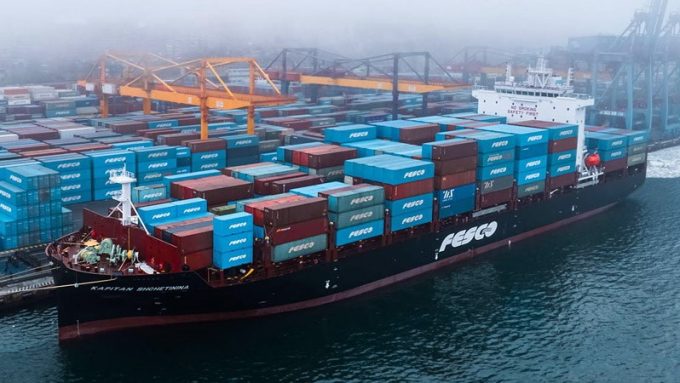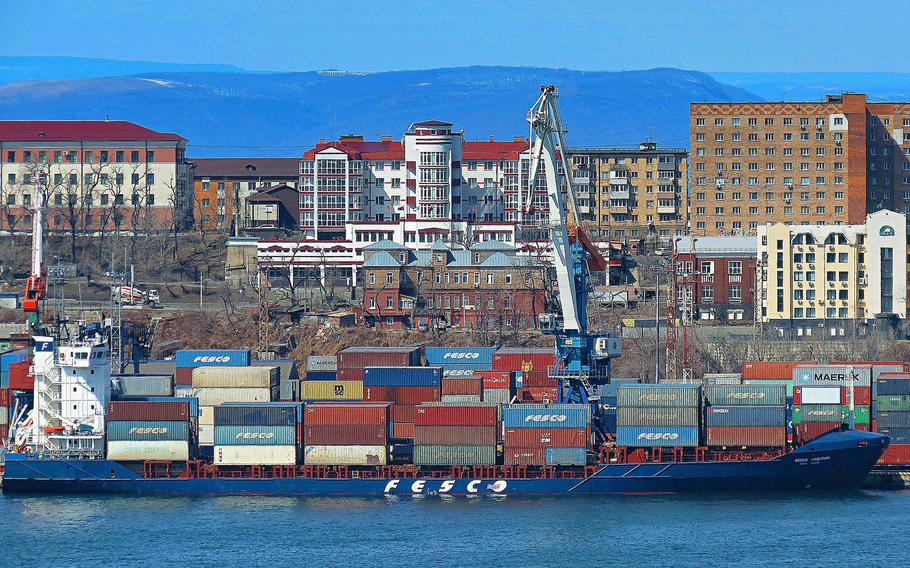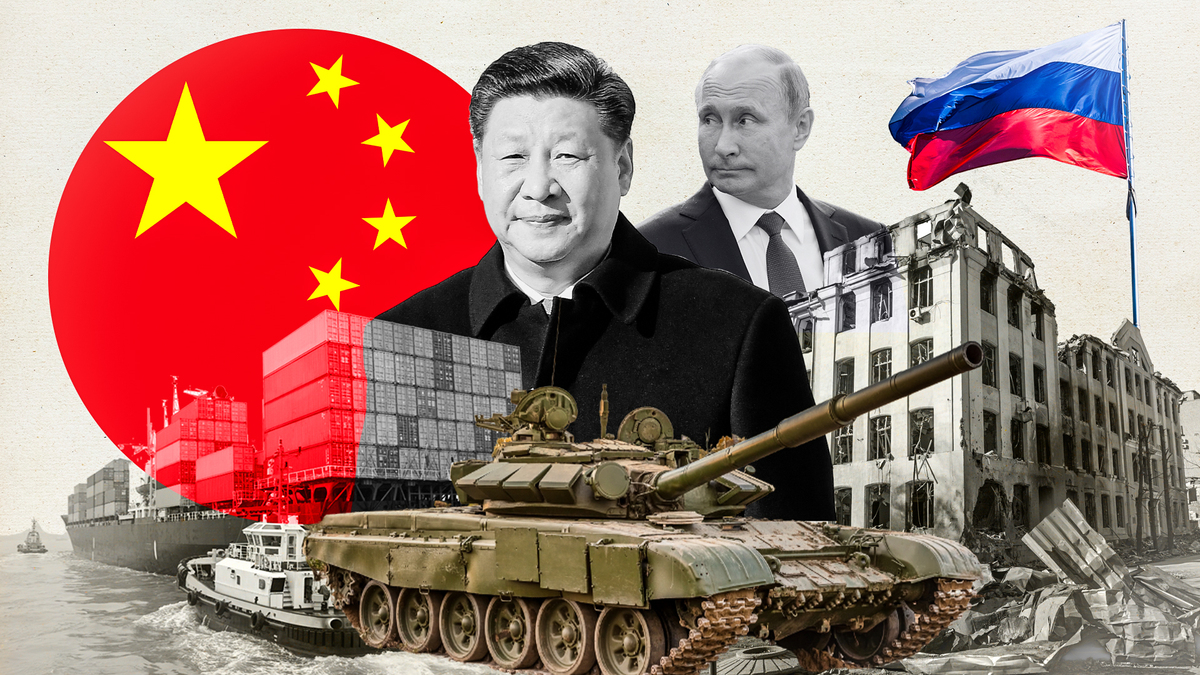Shipping Containers Pile Up In Light Of Booming Trade Between China And Russia, Heightening Concerns Of ‘Trade Money’ Being Used To Fund Russia-Ukraine Conflict
The burgeoning trade relationship between Russia and China has captured global attention, with both nations expanding their economic ties in recent months, so much so that shipping containers are said to be piling up. However, as the trade between the two nations is flourishing, there is growing concern about the funds being used to support the ongoing Russia-Ukraine conflict. Thus shedding light on the intricate interplay between trade, geopolitical dynamics, and the military, demonstrating how trade can support war and raise questions about the evolving role of international commerce in contemporary conflicts.

According to a recent analysis, the surge in trade between Russia and China has led to a surplus of shipping containers in Russia, causing a logistical challenge.
A new report has revealed that an excess of 150,000 shipping containers from China have accumulated in Russia due to the significant increase in Chinese goods entering the country; this information was disclosed by Container xChange, a logistics platform, citing data from one of its customers.
The CEO of Container xChange, Christian Roeloffs, noted in the report that there is a notable flow of cargo from China to Russia but a scarcity of containers returning from Russia to China; as a result, shipping containers are accumulating in Russia, leading to a considerable drop in secondhand container prices within the country.

Russia-China Evolving Partnership
This trade boom between Russia and China has been driven, in part, by Russia’s reliance on China as an economic lifeline following the Ukraine invasion.
Russia’s increasing dependence on China can be attributed to the fact that the United States and its allies have imposed sanctions and reduced trade with Russia to hinder its war efforts.
China, on the other hand, has strengthened its strategic partnership with Russia and positioned itself as a crucial supplier of consumer goods and energy to the Russian market despite declaring neutrality in the Ukraine conflict.
Container xChange attributes this situation to the growing trade imbalance between Russia and China, particularly concerning the types of products transported by containers, leading to the oversupply of shipping containers in Russia, which has resulted in a seven-fold decrease in the price of 40-foot containers since the previous year.
Chinese customs data from the first eight months of 2023 revealed a 32% increase in bilateral trade compared to the same period in the previous year, reaching a total trade volume of $155 billion.
The growth was driven by a significant surge in Chinese exports to Russia, which saw a 63.2% increase year-on-year, totalling $71.8 billion; simultaneously, imports into China also rose, albeit at a more modest rate of 13.3%, reaching $83.3 billion.
Russia set ambitious goals for its trade with China, aiming to reach a record $200 billion this year, a year ahead of the schedule established by Presidents Vladimir Putin and Xi Jinping in 2019.

This growing economic partnership has redirected Russian energy trade eastward, raising concerns that China’s support may indirectly support Russia’s actions in Ukraine.
Container xChange’s report pointed to China’s purchases of Russian raw materials, which are predominantly transported via rail tanks and open wagons rather than in containers. On the other hand, Chinese suppliers have been selling cars and consumer electronics to Russia, as many global brands exited the Russian market after the Ukraine invasion.
Moreover, nearly one-fifth of China’s crude oil imports in July came from Russia, according to the Organization of the Petroleum Exporting Countries (OPEC) and together with India, China accounted for 80% of Russian oil exports in July, as reported by the International Energy Agency in August.
Container xChange also highlighted broader logistical challenges related to shifting trade patterns and congestion, including overloaded Russian ports and roads; while some infrastructure improvements have been made, fiscal constraints and budgetary challenges have complicated these efforts.

China Defies Western Sanctions On Russia
China has called for the deepening of trade ties with Russia and greater cross-border connectivity, reaffirming its commitment to closer economic cooperation despite Western criticism following Russia’s invasion of Ukraine last year.
The Russian Minister of Economic Development had engaged in comprehensive talks on economic cooperation with the Chinese Commerce Minister during discussions in Beijing.
The meetings coincided with a visit by China’s top diplomat, Wang Yi, to Moscow, where strategic talks were held, culminating in confirming Russian President Vladimir Putin’s upcoming visit to Beijing.
China’s demand for oil, gas, and grain has provided critical support to Russia’s economy, even as the conflict in Ukraine enters its second year, and with Russia facing Western sanctions, Moscow has increasingly relied on Beijing for economic support.
According to the latest Chinese customs data, Chinese imports of Russian goods rebounded in August, increasing by 3% compared to the previous year, following an 8% decline in July.
China rejected Western criticism of its growing partnership with Moscow, asserting that its actions are in line with international norms and that it has the right to collaborate with any country it chooses.
Recently, the Russian Far East, which shares borders with China and North Korea, has gained strategic importance as a hub for cross-border trade and commerce, helping Russia to diversify its commodity exports away from Europe, which it now views as politically “unfriendly.”
The Russian Far East, responsible for about 70% of the country’s seafood production, also aims to increase exports of marine products to China following Beijing’s ban on seafood from Japan due to concerns about radioactive water release from the damaged Fukushima plant into the ocean.
Chinese state media has also emphasized the growing need for China and Russia to enhance their grain trading activities, given ongoing global supply constraints. The construction of a grain corridor linking Russia to Heilongjiang, China’s northeastern breadbasket, is seen as vital to bolster China’s food security.

The Role of Chinese Trade in Boosting Russia’s War Efforts
Chinese firms have emerged as pivotal players in bolstering Russia’s struggling economy and enhancing its military capabilities, with a particular focus on supplying goods for use in the ongoing conflict in Ukraine.
Russian customs data from as recently as August 2023 indicate a continuous flow of imports from China, including drones, helmets, vests, and radios; these goods not only serve as a lifeline for President Vladimir Putin’s enduring 18-month war but also represent a lucrative avenue for Chinese companies.
Moreover, lesser-documented Chinese exports ostensibly intended for civilian purposes, such as vehicles, construction equipment, and synthetic materials, are providing both direct and indirect support to Russia’s war efforts, as analysts have pointed out.
This robust trade persists despite Beijing’s insistence that its economic engagement with Moscow constitutes “normal economic cooperation” without targeting any “third party.”
These remarks follow the release of a U.S. intelligence report in July, which suggested that China has increasingly become a crucial support system for Russia in its war effort, potentially supplying Moscow with essential technology and dual-use equipment utilized in Ukraine.

Examples of the goods supplied include navigation equipment, jamming technology, and fighter jet parts. Ukrainian authorities have reported an increasing presence of Chinese components in weapons used by the Russian military since April 2023, coinciding with the “no limits partnership” reaffirmed by Putin and Li Shangfu, the former Chinese defense minister.
While the Ukrainian Defense Ministry and the Ukrainian Armed Forces general staff have yet to comment on these battlefield findings, the trade relationship between Russia and China continues to grow.
Total bilateral trade between the two nations reached a record high of $190 billion in 2022, marking a 30% increase from 2021. This year’s trade figures are on track to surpass that record, with total trade exceeding $134 billion in the first seven months of 2023.
China now constitutes around half (45%-50%) of Russia’s imports, up from one-quarter before the conflict began. This includes the trade of dual-use items and technologies with civilian and military applications, such as drones and microchips.
Despite DJI’s announcement that it had halted sales to both Russia and Ukraine in April 2022 and had forbidden sales by dealers to these countries for combat use, DJI drones were registered in Russia between September 2022 and January 2023; the registration included imports directly from DJI and indirectly from Chinese exporters.

Several Russian importers were identified in these transactions, including Nebesnaya Mekhanika, Vodukh, and Pozitron, which imported various goods, including drones, batteries, and helmets. These items can serve multiple purposes, from powering electronic devices to supporting military operations.
Analysts have noted that these irregular import patterns indicate opportunistic business behaviour on both sides, seizing the opportunity to fulfil Moscow’s military needs.
Additionally, China has been exporting goods with potential military implications, such as Aramid fiber, a heat-resistant synthetic fiber with various applications. Chinese shipments of Aramid fiber to Russia surged by more than 350% in dollar value in 2022 compared to 2021.
Often overlooked but significant construction equipment has also played a role in supporting Russia’s war efforts. Imports of Chinese earth-moving front-end shovel loaders and excavators to Russia in the first seven months of 2023 were considerably higher than the previous year.
Chinese heavy-duty trucks have witnessed an eleven-fold increase in value terms between January and May 2023 compared to the same period in 2021. These trucks have diverse applications, from civilian to military use.
Even though Chinese exports may not be directly deployed on the frontlines, they provide vital economic assistance to Russia, enabling Moscow to maintain the production output essential for both civilian and military needs.
These findings contribute to a growing body of evidence suggesting that Chinese goods and companies, including state-owned enterprises, support Russia’s military endeavours.
When asked to comment on the intelligence report and dual-use goods trade, China’s commerce ministry reiterated its stance of a trading relationship based on “mutual respect and mutual benefit.” The ministry emphasized that it would not exacerbate the situation in Ukraine and had no intention of taking advantage of it.
The trade dynamics between China and Russia have evolved significantly. China now plays a substantial role in supporting Russia’s military efforts despite the international implications and potential consequences of such actions.
The Last Bit, The symbiotic relationship between Russia and China in the realm of trade has become a topic of intense scrutiny, especially concerning their collaboration in Russia’s ongoing conflict in Ukraine.
Despite Beijing’s insistence on maintaining a “normal economic cooperation stance,” the evidence points to more intricate trade interactions with far-reaching implications.



